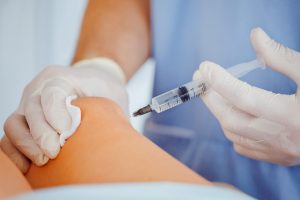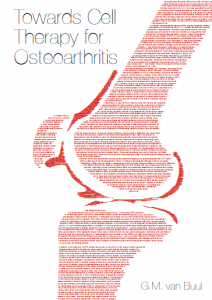Can stem cell therapy repair damaged cartilage in the future?

What is stem cell therapy?
Stem cell therapy can be considered a new, and revolutionary, treatment option in medicine. It is all about stem cells that can change into another cell type. For example, an embryo in the first stage exclusively consists of stem cells. After that, these undifferentiated cells are able develop into skin cells, organ cells, bone cells, nerve cells, fat cells and, of course, cartilage cells. In stem cell therapy, the damaged, defective or lost cells, are replaced by stem cells.
Stem cells are taken from the bone marrow, liver, fat, or blood of the patient. Then these “precursor cells” are multiplied in a laboratory. Soon after the stem cells are assigned a specialty, which means they are programmed to become a particular cell type. Finally the cells are introduced to the site of the affected tissue. Ideally this should repair the damage. Of course, a lot of research is currently underway using stem cells that could potentially develop into cartilage-producing cells. This could result in actual recovery of cartilage, until recently there has been little success. Unfortunately during these studies, the new cartilage cells soon changed into bone cells. Therefore, while the research of Twente University can be regarded as a major breakthrough, it was not a complete success.
Stem cells reduce inflammatory processes

Unfortunately, as discussed previously, this was not the case. Nevertheless, there was a promising result! The stem cells reduced the inflammatory processes and inhibited cartilage degradation. There are currently studies happening to observe what affects stem cells have on cartilage. The goal is to develop a drug with similar effect, based on the resulting information. This could potentially result in a (osteo)arthritis treatment with similar results, but less expensive than stem cell therapy. In addition, such a drug may also be used to prevent joint damage.
Cultured cartilage remains cartilage
A major step in the right direction was made last year by researchers from MIRA research institute, which is part of the University of Twente in the Netherlands. The researchers managed to grow cells that produced stable cartilage in the body of a mouse. A major breakthrough, because cultured cartilage is usually converted to bone tissue within five weeks. This remarkable result was achieved by applying a simple trick. By default, cartilage cells are grown at an oxygen concentration of 21 percent, which is similar to the external environment. However, in the body cartilage oxygen concentration is a lot lower because there are no blood vessels present. By reducing the oxygen concentration during the cultivation process to 2.5 percent, the researchers managed to produce stable and permanent cartilage (read the source article of this study.)
Further research is required to understand the mechanism of action (MOA) of cultured cartilage cells and to improve the growth of cartilage tissue for tissue translation. This will eventually lead to new treatment methods to prevent, inhibit and fight osteoarthritis.
Stem cells from belly fat
Peter van Lent of the Rheumatic Disease Department of UMC St Radboud in Nijmegen Netherlands has also investigated the use of stem cells in joint problems. His conclusion is that injecting stem cells from abdominal fat into inflamed joints seems to help against osteoarthritis. This method mainly reduces inflammatory reactions in the joint’s inner lining. Van Lent works with other European researchers on this project (read the source article.) In mice, rabbits and goats this therapy has been successfully applied. Currently, in Germany and France, a limited number of patients with osteoarthritis are taking part in the study to see whether this method is safe.
Fortune telling
Although stem cell therapy is still in its infancy, developments are going rapidly. During the search for ultimate osteoarthritis therapy, hopeful results have already been achieved in mice, rabbits and goats. Now we have to wait whether this research will ultimately lead to a successful treatment for osteoarthritis. That will remain fortune telling for a while. It is not for the first time that good results in animal research eventually end up being different in humans. The investigators however, have a positive feeling and think that successful stem cell therapy in osteoarthritis will be eventually successful. We will keep you informed!
Current developments regarding stem cell therapy in arthritis
Large-scale European stem cell research
Currently, a major clinical trial is being conducted regarding the treatment of osteoarthritis with stem cells. This study, funded by the European Union, involves 18 hospitals in The Netherlands, France, England, Germany and Italy, just to name a few. The Radboud UMC in Nijmegen has now found enough patients for this innovative therapy and therefore sign up is no longer possible. This project is a follow-up to a similar study from 2014. Eighteen patients were then injected with raised stem cells from their own abdominal fat. Since this method proved safe, it is now being investigated whether this method is also effective for new and stable cartilage to be formed. We have to be patient however. It certainly takes a number of years before the final results of this European research are known. With positive results, stem cell therapy may hopefully be offered as a regular treatment.
Horses, dogs and cats: stem cell therapy is applied!
Stem cell therapy has been used in animal medicine for several years. Horse tendon injuries occur frequently, due to this fact researchers are focusing on introducing stem cells that become tendon tissue to replace damaged tendons. In principle, every cell in the body can differentiate into any desired organ cell under the right conditions. To this end, stem cells from the horse are harvested from the sternum. These undifferentiated cells are then processed in the laboratory, and in this case turned into differentiated tendon cells.
This is a costly experimental procedure that must be expertly executed. Although success has been achieved, the average success rate is around 40%. Stem cell therapy is also combined with Platelet Rich Plasma Injection (PRP) therapy. The cost of such treatment can range from 1250 to 1500 euros. The improvement of arthritis in horses with stem cell therapy is still in its infancy. In this area, more research has been done on dogs and cats with a greater return. It appears that on average 85 percent of dogs and cats benefit from stem cell therapy of the joints, whose issues decrease by 40 percent on average. You can read the entire article here.
Scientists now know how stem cells work
Stem cell therapy produces promising results in repairing damaged cartilage in animals. Until recently it was still unclear whether the stem cells are responsible for the growth of new tissue or that they initiate the body processes. Researchers at the University of Vienna have now found the answer to this question. The Austrian team following the effect of stem cell therapy in specially bred mice and rats discovered that stem cells do not participate in the regeneration of damaged cartilage. However, they stimulate the present cartilage cells to create new specimens.

Share this page
Tweet

Download for free the booklet ‘Moving without pain’ with a retail value of $6.75 / £4.95.
Any questions? Please feel free to contact us. Contact us.





